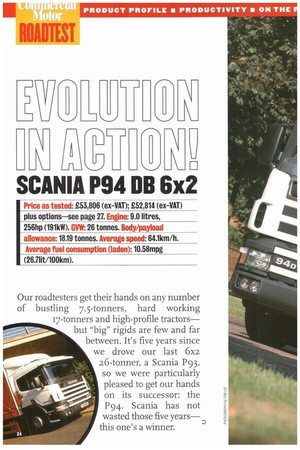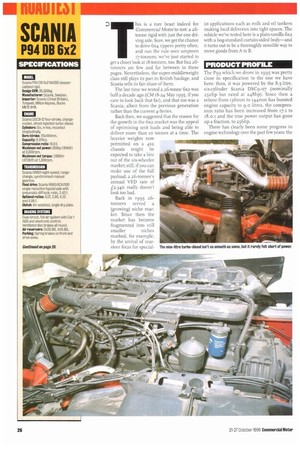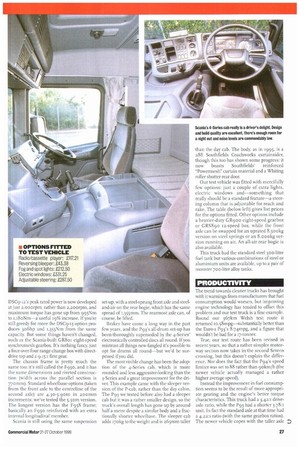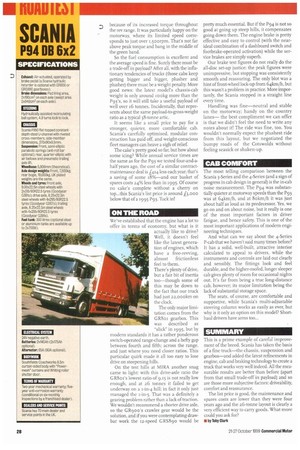SCANIA P94 DB 6x2
Page 26

Page 28

Page 29

Page 30

If you've noticed an error in this article please click here to report it so we can fix it.
IPrice as tested: £53,806 (ex-VAT); £52,814 (ex-VAT) plus options—see page 27. Engine: 9.0 litres, 256hp (191kW). GM 26 tonnes. Body/payload allowance: 18.19 tonnes. Average speed: 64.1km/h. Average fuel consumption (laden): 10.58mpg (26.71it/100km).
Our roadtesters get their hands on any number of bustling 7.5-tonners, hard working 17-tonners and high-profile tractors— but "big" rigids are few and far between. It's five years since we drove our last 6x2 26-tormer, a Scania P93,
so we were particularly pleased to get our hands on its successor: the P94. Scania has not wasted those five years— this one's a winner.
his is a rare beast indeed for Commercial Motor to test: a 26tonne rigid with just the one driving axle. Sure, we get the chance to drive 6x4 tippers pretty often, and run the rule over umpteen 17-tonners; we've just started to
get a closer look at 18-formers, too. But 6x2 26tonners are few and far between in these pages. Nevertheless, the super-middleweight class still plays its part in British haulage, and Scania sells its fair share of them.
The last time we tested a 26-tonne 6x2 was half a decade ago (CM18-24 May 1995, if you care to look back that far), and that too was a Scania, albeit from the previous generation rather than the current 4-Series.
Back in 1995 26ton ners served a (growing) niche market. Since then the market has become fragmented into still
smaller niches marked, for example, by the arrival of rearsteer 6x2s for special ist applications such as milk and oil tankers making local deliveries into tight spaces. The vehicle we've tested here is a plain-vanilla 6x2 with a bog-standard curtain-sided body—and it turns out to be a thoroughly sensible way to move goods from A to B.
PRODUCT PROFILE
The P93 which we drove in 1995 was pretty close in specification to the one we have here: then, it was powered by the 8.5-litre, six-cylinder Scania DSC 9-o7 (nominally 25 ohp but rated at 248hp). Since then a rebore from 136mm to 144mm has boosted engine capacity to 9.0 litres, the compression ratio has been increased from 17.1 to 18.0:1 and the true power output has gone up a fraction, to 256hp.
There has clearly been some progress in engine technology over the past few years: the
DSC9-12's peak rated power is now developed at lust 2,000rpm, rather than 2,200rpm, and maximum torque has gone up from 995Nm to nr8oNm—a useful 19% increase. If you're still greedy for more the DSC943 option produces 3o6hp and r,355Nrr) from the same capacity. But some things haven't changed, such as the Scania-built GRSoi eight-speed synchromesh gearbox. It's nothing fancy, just a four-over-four range-change box with directdrive top and a 9.15:1 first gear.
The chassis frame is pretty much the same too: it's still called the F95o, and it has the same dimensions and riveted construction (width across the parallel section is romm). Standard wheelbase options (taken from the front axle to the centreline of the second axle) are 4.3o-5.9om in 200MM increments; we've tested the 5.3om version. The longest version has the F958 frame; basically an F95o reinforced with an extra internal longitudinal member
Scania is still using the same suspension set-up, with a steel-sprung front axle and steeland-air on the rear bogie, which has the same spread of 1,355mm. The rearmost axle can, of course, be lifted.
Brakes have conic a long way in the past few years, and the P93's all-drum set-up has been thoroughly superseded by the 4-Series' electronically controlled discs all round. If you mistrust all things new-fangled it's possible to opt for drums all round—but we'd be surprised if you did.
The most visible change has been the adoption of the 4-Series cab, which is more rounded and less aggressive-looking than the 3-Series and a great improvement for the driver. This example came with the sleeper version of the P-cab, rather than the day cabin. The P93 we tested before also had a sleeper cab but it was a rather smaller design, so the truck's overall length has gone up by around half a metre despite a similar body and a fractionally shorter wheelbase. The sleeper cab adds 170kg to the weight and is 265mm taller
than the day cab. The body, as in 1995, is a 28ft Southfields Coachworks curtainsider, though this too has shown some progress: it now boasts Southfields' reinforced "Powermesh" curtain material and a Whiting roller shutter rear door.
Our test vehicle was fitted with mercifully Few options: just a couple of extra lights, electric windows and—something that really should be a standard feature—a steering column that is adjustable for reach and rake. The table (below left) gives list prices for the options fitted. Other options include a heavier-duty GR9oo eight-speed gearbox or GRS890 r2-speed box, while the front axle can be swapped for an uprated 8,5ookg version on steel springs or an 8,000kg version running on air. An all-air rear bogie is also available.
This truck had the standard steel 300-litre fuel tank but various combinations of steel or aluminium units are available, up to a pair of monster 700-litre alloy tanks.
PRODUCTIVITY
The trend towards cleaner trucks has brought with it warnings from manufacturers that fuel consumption would worsen, but improving engine technology has tended to offset this problem and our test truck is a fine example. Round our 367km Welsh test route it returned to.58mpg—substantially better than the Euro-i P 93's 8.74mpg, and a figure that wouldn't be bad for a r7-tonnen True, our test route has been revised in recent years, so that a rather simpler motorway section now takes in the second Severn crossing, but this doesn't explain the difference. Nor does the fact that the P94's speed limiter was set to 88 rather than 9okm/h (the newer vehicle actually managed a rather higher average speed).
Instead the improvement in fuel consumption seems to be the result of more appropriate gearing and the engine's better torque characteristics. This truck had a 3.42:1 driveaxle ratio, while the P93 had a shorter 3.78:1 unit. In fact the standard axle at that time had a 4.22;1 ratio (with the same gearbox ratios). The newer vehicle copes with the taller axle because of its increased torque throughout the rev range. It was particularly happy on the motorway, where its limited speed conesponds to just over 1,5oorprn. That's not far above peak torque and bang in the middle of the green band.
So the fuel consumption is excellent and the average speed is fine. Surely there must be a trade-off in payload? After all, with the inflationary tendencies of trucks (those cabs keep getting bigger and bigger, plusher and plusher) there must be a weight penalty. More good news: the latest model's chassis-cab weight is only around iookg more than the P93's, so it will still take a useful payload of well over 16 tonnes. Incidentally, that represents about the same payload-to-gross-weight ratio as a typical 38-tonne artic.
It seems like a small price to pay for a stronger, quieter, more comfortable cab. Scania's carefully optimised, modular construction has paid off, and weight-conscious fleet managers can heave a sigh of relief.
The cake's pretty good so far, but how about some icing? While annual service times are the same as for the P93 we tested four-and-ahalf years ago, the cost of a similar contractmaintenance deal is £414 less each year; that's a saving of some r8%—and our basket of spares costs 24% less than in 1995. Of course no cake's complete without a cherry on top.. this Scania's list price is around £3,000 below that of 2 1995 P93. Tuck in!
ON THE ROAD
We've established that the engine has a lot to offer in terms of economy, but what is it actually like to drive? Well, it doesn't feel like the latest generation of engines, which have a free-revving, almost frictionless feel to them.
There's plenty of drive, but a fair bit of inertia too—though some of this may be down to the fact that our truck had just 22,000krri on the clock.
The only major limitation comes from the GR8o1 gearbox. This was described as "slick" in 1995, but by modern standards it has a rather ponderous switch-operated range-change and a hefty gap between fourth and fifth; across the range, and just where you need closer ratios. This particular quirk made it all too easy to lose drive on steepening hills.
On the test hills at MIRA another snag came to light: with this drive-axle ratio the GR8or's lowest ratio of 9.15 is not really low enough, and at 26 tonnes it failed to get underway on a 1-in-4 hill; in fact it only just managed the t-in-5. That was a definitely a gearing problem rather than a lack of traction. We wouldn't recommend a shorter drive axle, so the GR9oo's crawler gear would be the solution, and if you were contemplating drawbar work the 12-speed G RS890 would be pretty much essential. But if the P94 is not so good at going up steep hills, it compensates going down them. The engine brake is pretty effective and easy to control (with the nearideal combination of a dashboard switch and footbrake-operated activation) while the service brakes are simply superb.
Our brake test figures do not really do the all-disc set-up justice: the peak figures were unimpressive, but stopping was consistently smooth and reassuring. The only blot was a hint of front-wheel lock-up from 64km/h, but this wasn't a problem in practice. More importantly, the Scania stopped in a straight line every time.
Handling was fine—neutral and stable on the motorway; handy on the country lanes— the best compliment we can offer is that we didn't feel the need to write any notes about it! The ride was fine, too. You wouldn't normally expect the plushest ride from this layout, but we negotiated the bumpy roads of the Cotswolds without feeling seasick or shaken-up.
CAB COMFORT
The most telling comparison between the Scania 3-Series and the 4-Series (and a sign of progress in cab design in general) is the in-cab noise measurement, The P94 was substantially quieter at motorway speeds than the P93 was at 64km/h, and at 8okm/h it was just about half as loud as its predecessor. Yes, we go on and on about noise, but it really is one of the most important factors in driver fatigue, and hence safety. This is one of the most important applications of modern engineering techniques.
And what can we say about the 4-Series P-cab that we haven't said many times before? It has a solid, well-built, attractive interior calculated to appeal to drivers, while the instruments and controls are laid out clearly and sensibly. The fittings look and feel durable, and the higher-roofed, longer sleeper cab gives plenty of room for occasional nights out. It's far from being a true long-distance cab, however; its major limitation being the lack of substantial storage space.
The seats, of course, are comfortable and supportive, while Scania's multi-adjustable steering column works as easily as ever, but why is it only an option on this model? Shorthaul drivers have arms too...
SUMMARY
This is a prime example of careful improvement of the breed. Scania has taken the basis of a fine truck—the chassis, suspension and gearbox—and added the latest refinements in engine, cab and braking technology to create a truck that works very well indeed. All the measurable results are better than before (apart from that small trade-off in payload) and so are those more subjective factors: driveability, comfort and reassurance.
The list price is good, the maintenance and spares costs are lower than they were four years ago and the 2,6-tonne layout is clearly a very efficient way to carry goods. What more could you ask for?
IN by Toby Clark
SCANIA
P94 DB 6x2
SPECIFICATIONS
MODEL Scam P94 DO 6x2 IVA260 sleepercabbed rigid.
Design GVW: 26,500kg. Manufacturer: Scania, Sweden. Importer: Scania (Great Britain), Tongwell, Milton Keynes, Bucks MK15 8HB.
MINE
Scania DSC9-12 four-stroke, chargecooled, directiruection turbo-diesel. Cylinders: Six, in line, mounted longtudinally. Borelstroke:115x144mm.
Capacity: 8,974cc.
Compression ratio: 18.0:1.
Maximum net power: 2561tp (191kW) at 2,000rpm.
Ma:drnum net torque 1,180Nm
( 870Ibft at 1,300rpm.
TRANSMISSION Scania GR801 eight-speed, rangechange, synchromesh manual gearbox.
Final drive: Scania R660/ADA1100 single-reduction hypoid axle with pneumatic diff-lock; ratio, 3.42:1. Optional ratios: 3.07, 3.80, 4.22 and 4.88:1.
gulch: Air-assisted, single dry plate.
E=I
Dual-circuit, full-air system with Cat 1 ABS and electronic control. Ventilated disc brakes all round. Air reseryoire 2x28.8Itt.1x14.81it.. Parking: Spnng brakes on front and drive axles.
Continued on page 28.
• OPTIONS FITT= TO TEST VEHICLE
Radio/cassette player: 1117.21 Reversing bleeper: £43.38 Fog and spot lights: 1212.50 Electric windows: £331.25 Adjustable steering: 1287.50
SCANIA
P94 DB 6x2
SPECIFICATIONS
Fidtaust Air-actuated, operated by brake pedal (a Scania hydraulic retarder is optional with GR900 or GRS890 geaftoxes).
Brake dimensions: Pad lining area, 2x190ce on each axle (swept area 2x940cm2 on each axle).
STEERING
Hydraulically assisted recirculating ball system, 4.9 turns lock to lock.
CHASSIS
Scania F950 flat-topped constantdepth-steel U-channel with riveted cross-members; side-member dimensions, 270x90x9.5mm. Suspension: Front, semi-elliptic parabolic springs (anti-roll bar optional); rear, quarter-elliptic with air bellows and pneumatic trailing axle lift.
Illieelbaslx 5,906mm (theoretical). Axle design weights Front, 7,500kg; rear bogie, 19,000kg. UK plated weights are the same.
Meals and tyres: Front axle, 9.00x22.5in steel wheels with 2x315/80R22.5 tyres (Goodyear G391s); drive axle, 8.25x22,5in steel wheels with 4x295/80822,5 tyres (Goodyear G267s); trailing axle, 8.25x22,5in steel wheels with 4 x295/80f122.5 tyres (Goodyear G391s).
Fuel tank: 300 litres (optional steel or aluminium tanks are available up to 2x7001it),
ELECTRICAL SYSTEM
24V negative earth.
Bettorietz 2x140Ah (2x175Ah optional).
Alternator: 65A (90A optional).
BODYWORK
Southfields Coachworks 8.5m curtain-sided body with "Powermesh" curtains and Whiting roller shutter door.
TERMS OF WARRANTY
Two-year mechanical warranty; fiveyear anti-corrosion warranty (conditional on six-monthly inspections by a franchised dealer).
DEALERS AND SERVICE POINTS
Scania has 70 main dealer and service points in the UK.












































































































